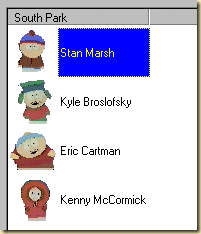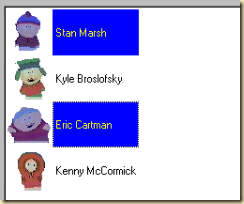使用Custom Draw优雅的实现ListCtrl的重绘[转]
Common control 4.7版本介绍了一个新的特性叫做Custom Draw,这个名字显得模糊不清,让人有点摸不着头脑,而且MSDN里也只给出了一些如风的解释和例子,没有谁告诉你你想知道的,和究竟这个特性有什么好处。
Custom draw可以被想象成一个轻量级的,容易使用的重绘方法(重绘方法还有几种,例如Owner Draw等)。这种容易来自于我们只需要处理一个消息(
NM_CUSTOMDRAW),就可以让Windows为你干活了,你就不用被逼去处理"重绘过程"中所有的脏活了。这篇文章的焦点是如何在一个LISTCTRL控件上使用Custom Draw消息。究其原因,一部分是因为我已经在我的工作上使用了Custom Draw有一段时间了,我很熟悉它。另一个原因是这个机制确实是非常好用,你只需要写很少量的代码就可以达到很好的效果。使用 Custom draw 来对控件外观编程甚至可以代替很多的古老方法。
以下代码是在WIN98 和VC6 SP2的环境下写的,common controls DLL的版本是5.0。我已经对其在WinNT 4上进行了测试。系统要运行这些代码,它的common controls DLL的版本必须至少是4.71。但随着IE4 的发布,这已经不是问题了。(IE会夹带着这个DLL一起发布)
Custom Draw 基础
我将会尽我所能把Custom Draw的处理描述清楚,而不是简单的引用MSDN的文档。这些例子都需要你的程序有一个ListCtrl在对话框上,并且这个ListCtrl处于Report和多列模式。
Custom Draw 的消息映射入口
Custom draw 是一个类似于回调的处理过程,Windows在绘制List Ctrl的某个时间点上通过 Notification 消息通知你的程序,你可以选择忽略所有的通知(这样你就会看到标准的ListCtrl),或者处理某部分的绘制(实现简单的效果),甚至整个的控件都由你来绘制(就象使用Owner-Drawing一样)。这个机制的真正卖点是:你只需要实现一些你需要的,其余的可以让Windows为你代劳。
好了,现在你可以开始为你的ListCtrl添加Custom Draw去做一些个性化的事情了。你首先要有正确的Comm Ctrl Dll版本,然后Windows会为你发送
NM_CUSTOMDRAW消息,你只需要添加一个处理函数以便开始使用Custom draw。首先添加一个消息映射,象下面一样:ON_NOTIFY ( NM_CUSTOMDRAW, IDC_MY_LIST, OnCustomdrawMyList )
处理函数的原形如下:
afx_msg void OnCustomdrawMyList ( NMHDR* pNMHDR, LRESULT* pResult );
这就告诉MFC你要处理从你的ListCtrl控件发出的
WM_NOTIFY消息,ID为IDC_MY_LIST,通知码为NM_CUSTOMDRAW,OnCustomdrawMyList就是你的处理函数。如果你有一个从ClistCtr派生的类,你想为它添加custom draw,你就可以使用
ON_NOTIFY_REFLECT来代替。如下:ON_NOTIFY_REFLECT ( NM_CUSTOMDRAW, OnCustomdraw )
OnCustomdraw的原形和上面的函数一致,但它是声明在你的派生类里的。
Custom draw将控件的绘制分为两部分:擦除和绘画。Windows在每部分的开始和结束都会发送NM_CUSTOMDRAW消息。所以总共就有4个消息。但是实际上你的程序所收到消息可能就只有1个或者多于四个,这取决于你想要让WINDOWS怎么做。每次发送消息的时段被称作为一个“绘画段”。你必须紧紧抓住这个概念,因为它贯穿于整个“重绘”的过程。
所以,你将会在以下的时间点收到通知:
l 一个item被画之前——“绘画前”段
l 一个item被画之后——“绘画后”段
l 一个item被擦除之前——“擦除前”段
l 一个item被擦除之后——“擦除后”段
并不是所有的消息都是一样有用的,实际上,我不需要处理所有的消息,直到这篇文章完成之前,我还没使用过擦除前和擦除后的消息。所以,不要被这些消息吓到你。
NM_CUSTOMDRAW Messages提供给你的信息:
l NM_CUSTOMDRAW消息将会给你提供以下的信息:
l ListCtrl的句柄
l ListCtrl的ID
l 当前的“绘画段”
l 绘画的DC,让你可以用它来画画
l 正在被绘制的控件、item、subitem的RECT值
l 正在被绘制的Item的Index值
l 正在被绘制的SubItem的Index值
l 正被绘制的Item的状态值(selected, grayed, 等等)
l Item的LPARAM值,就是你使用
CListCtrl::SetItemData所设的那个值上述所有的信息对你来说可能都很重要,这取决于你想实现什么效果,但最经常用到的就是“绘画段”、“绘画DC”、“Item Index”、“LPARAM”这几个值。
一个简单的例子:
好了,经过上面的无聊的细节之后,我们是时候来看一些简单的代码了。第一个例子非常的简单,它只是改变了一下控件中文字的颜色。
处理的代码如下:
void CPanel1::OnCustomdrawList ( NMHDR* pNMHDR, LRESULT* pResult )
{
NMLVCUSTOMDRAW* pLVCD = reinterpret_cast<NMLVCUSTOMDRAW*>( pNMHDR );
// Take the default processing unless we set this to something else below.
*pResult = 0;
// First thing - check the draw stage. If it's the control's prepaint
// stage, then tell Windows we want messages for every item.
if ( CDDS_PREPAINT == pLVCD->nmcd.dwDrawStage )
{
*pResult = CDRF_NOTIFYITEMDRAW;
}
else if ( CDDS_ITEMPREPAINT == pLVCD->nmcd.dwDrawStage )
{
// This is the prepaint stage for an item. Here's where we set the
// item's text color. Our return value will tell Windows to draw the
// item itself, but it will use the new color we set here.
// We'll cycle the colors through red, green, and light blue.
COLORREF crText;
if ( (pLVCD->nmcd.dwItemSpec % 3) == 0 )
crText = RGB(255,0,0);
else if ( (pLVCD->nmcd.dwItemSpec % 3) == 1 )
crText = RGB(0,255,0);
else
crText = RGB(128,128,255);
// Store the color back in the NMLVCUSTOMDRAW struct.
pLVCD->clrText = crText;
// Tell Windows to paint the control itself.
*pResult = CDRF_DODEFAULT;
}
}
结果如下,你可以看到行和行间的颜色的交错显示,多酷,而这只需要两个if的判断就可以做到了。有一件事情必须记住,在做任何的绘画之前,你都要检查正处身的“绘画段”,因为你的处理函数会接收到非常多的消息,而“绘画段”将决定你代码的行为。
一个更小的简单例子:
下面的例子将演示怎么去处理subitem的绘画(其实subitem也就是列)
- 在ListCtrl控件绘画前处理NM_CUSTOMDRAW消息。
- 告诉Windows我们想对每个Item处理NM_CUSTOMDRAW消息。
- 当这些消息中的一个到来,告诉Windows我们想在每个SubItem的绘制前处理这个消息
- 当这些消息到达,我们就为每个SubItem设置文字和背景的颜色。
void CMyDlg::OnCustomdrawMyList ( NMHDR* pNMHDR, LRESULT* pResult )
{
NMLVCUSTOMDRAW* pLVCD = reinterpret_cast<NMLVCUSTOMDRAW*>( pNMHDR );
// Take the default processing unless we set this to something else below.
*pResult = CDRF_DODEFAULT;
// First thing - check the draw stage. If it's the control's prepaint
// stage, then tell Windows we want messages for every item.
if ( CDDS_PREPAINT == pLVCD->nmcd.dwDrawStage )
{
*pResult = CDRF_NOTIFYITEMDRAW;
}
elseif ( CDDS_ITEMPREPAINT == pLVCD->nmcd.dwDrawStage )
{
// This is the notification message for an item. We'll request
// notifications before each subitem's prepaint stage.
*pResult = CDRF_NOTIFYSUBITEMDRAW;
}
elseif ( (CDDS_ITEMPREPAINT | CDDS_SUBITEM) == pLVCD->nmcd.dwDrawStage )
{
// This is the prepaint stage for a subitem. Here's where we set the
// item's text and background colors. Our return value will tell
// Windows to draw the subitem itself, but it will use the new colors
// we set here.
// The text color will cycle through red, green, and light blue.
// The background color will be light blue for column 0, red for
// column 1, and black for column 2.
COLORREF crText, crBkgnd;
if ( 0 == pLVCD->iSubItem )
{
crText = RGB(255,0,0);
crBkgnd = RGB(128,128,255);
}
elseif ( 1 == pLVCD->iSubItem )
{
crText = RGB(0,255,0);
crBkgnd = RGB(255,0,0);
}
else
{
crText = RGB(128,128,255);
crBkgnd = RGB(0,0,0);
}
// Store the colors back in the NMLVCUSTOMDRAW struct.
pLVCD->clrText = crText;
pLVCD->clrTextBk = crBkgnd;
// Tell Windows to paint the control itself.
*pResult = CDRF_DODEFAULT;
}
}
执行的结果如下:
这里需要注意两件事:
l clrTextBk的颜色只是针对每一列,在最后一列的右边那个区域颜色也还是和ListCtrl控件的背景颜色一致。
l 当我重新看文档的时候,我注意到有一篇题目是“NM_CUSTOMDRAW (list view)”的文章,它说你可以在最开始的custom draw消息中返回CDRF_NOTIFYSUBITEMDRAW就可以处理SubItem了,而不需要在CDDS_ITEMPREPAINT绘画段中去指定CDRF_NOTIFYSUBITEMDRAW。但是我试了一下,发现这种方法并不起作用,你还是需要处理CDDS_ITEMPREPAINT段。
处理“绘画之后”的段
到限制为止的例子都是处理“绘画前”的段,当Windows绘制List Item之前就改变它的外观。然而,在“绘制前”,你的绘制行为时被限制的,你只能改变字体的颜色或者外观。如果你想改变图标的绘制,你可以在“绘画前”把整个 Item重画或者在“绘画后”去做这件事。当你做在绘画后去做“自定义绘画”是,你的“绘画处理函数”就会在Windows画完整个Item或者SubItem的时候被调用,你就可以随心所欲的乱画了!!
在这个例子里,我将创建一个ListCtrl,一般的ListCtrl的Item如果被选择了,则其Icon也会呈现出被选择的状态。而我创建的这个ListCtrl的Icon是不会呈现被选择的状态的。步骤如下:
- 对ListCtrl在“绘画前”处理NM_CUSTOMDRAW消息。
- 告诉Windows我们想在每个Item被画的时候获得NM_CUSTOMDRAW消息。
- 当这些消息来临,告诉Windows我们想在你画完的时候获取NM_CUSTOMDRAW消息。
- 当这些消息来到的时候,我们就重新画每一个Item的图标。
void CPanel3::OnCustomdrawList ( NMHDR* pNMHDR, LRESULT* pResult )
{
NMLVCUSTOMDRAW* pLVCD = reinterpret_cast<NMLVCUSTOMDRAW*>( pNMHDR );
*pResult = 0;
// If this is the beginning of the control's paint cycle, request
// notifications for each item.
if ( CDDS_PREPAINT == pLVCD->nmcd.dwDrawStage )
{
*pResult = CDRF_NOTIFYITEMDRAW;
}
else if ( CDDS_ITEMPREPAINT == pLVCD->nmcd.dwDrawStage )
{
// This is the pre-paint stage for an item. We need to make another
// request to be notified during the post-paint stage.
*pResult = CDRF_NOTIFYPOSTPAINT;
}
else if ( CDDS_ITEMPOSTPAINT == pLVCD->nmcd.dwDrawStage )
{
// If this item is selected, re-draw the icon in its normal
// color (not blended with the highlight color).
LVITEM rItem;
int nItem = static_cast<int>( pLVCD->nmcd.dwItemSpec );
// Get the image index and state of this item. Note that we need to
// check the selected state manually. The docs _say_ that the
// item's state is in pLVCD->nmcd.uItemState, but during my testing
// it was always equal to 0x0201, which doesn't make sense, since
// the max CDIS_ constant in commctrl.h is 0x0100.
ZeroMemory ( &rItem, sizeof(LVITEM) );
rItem.mask = LVIF_IMAGE | LVIF_STATE;
rItem.iItem = nItem;
rItem.stateMask = LVIS_SELECTED;
m_list.GetItem ( &rItem );
// If this item is selected, redraw the icon with its normal colors.
if ( rItem.state & LVIS_SELECTED )
{
CDC* pDC = CDC::FromHandle ( pLVCD->nmcd.hdc );
CRect rcIcon;
// Get the rect that holds the item's icon.
m_list.GetItemRect ( nItem, &rcIcon, LVIR_ICON );
// Draw the icon.
m_imglist.Draw ( pDC, rItem.iImage, rcIcon.TopLeft(),
ILD_TRANSPARENT );
*pResult = CDRF_SKIPDEFAULT;
}
}
}
重复,custom draw让我们可以做尽可能少的工作,上面的例子就是让Windows帮我们做完全部的工作,然后我们就重新对选择状态的Item的图标做重画,那就是我们看到的那个图标。执行结果如下:唯一的不足是,这样的方法会让你感觉到一点闪烁。因为图标被画了两次(虽然很快)。 用Custom Draw代替Owner Draw
另外一件优雅的事情就是你可以使用Custom Draw来代替Owner Draw。它们之间的不同在我看来就是:
l 写Custom Draw的代码比写Owner Draw的代码更容易。
如果你只需要改变某行的外观,你可以不用管其他的行的绘画,让WINDOWS去做就行了。但如果你使用
Owner Draw,你必须要对所有的行作处理。当你想对控件作所有的处理时,你可以在处理NM_CUSTOMDRAW
消息的最后返回CDRF_SKIPDEFAULT,这有点和我们到目前为止所做的有些不同。CDRF_SKIPDEFAULT
告诉Windows由我们来做所有的控件绘画,你不用管任何事。
我没有在这里包含这个例子的代码,因为它有点长,但是你可以一步步地在调试器中调试代码,你可以看到每一
步发生了什么。如果你把窗口摆放好,让你可以看到调试器和演示的程序,那在你一步步的调试中,你可以看到
控件每一步的绘制,这里的ListCtrl是很简单的,只有一列并且没有列头,如下:
如果需要看原文和下载例子程序,请到这个网址:
http://www.codeproject.com/KB/list/lvcustomdraw.aspx








